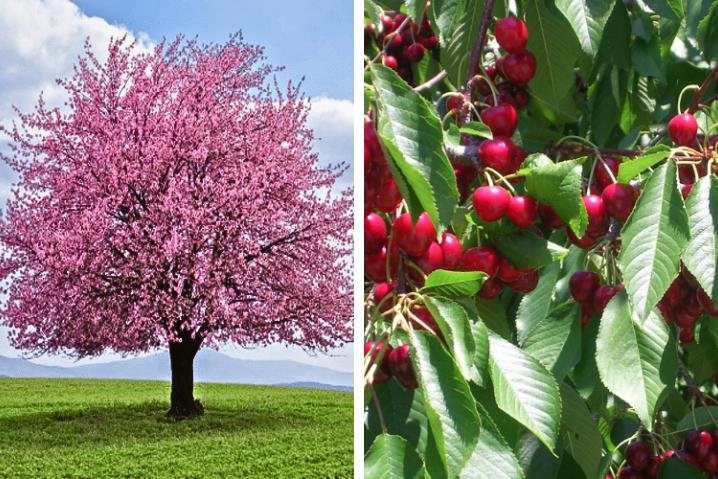What are hardwoods and softwoods? There are a couple of ways someone might classify them.
Hardwoods and softwoods are classifications of trees base on the science of tree reproduction.
But, there’s also the measure of lumber as a hard wood or soft wood, based on the Janka Hardness Scale for wood.
These are two different ways of describing wood. We’ll try to make the distinction.
We’ll also review characteristics of hardwoods and softwoods you should consider when thinking about which might be the best choice for exterior siding.
Hardwood and Softwood Tree Classifications
Hardwood trees and softwood trees are classified as such based upon tree reproduction with a set of descriptors, including leaf shape, seed casing, and flowering.
Hardwood trees (angiosperms) are deciduous, meaning they lose their leaves each year. The leaves are generally broad and flat. Hardwood trees flower each Spring, and their seeds are encased in a protective covering.
The covering can be a fruit, such as apple and cherry or a hard shell, like walnut and acorn. Cherry, oak, and walnut are just a few of the many hardwood trees.

Is cedar a hardwood or softwood?
Softwood trees (gymnosperms) are generally cone-bearing evergreens with needle-like leaves. Softwoods do not have true flowers. The seeds of a softwood are naked, with no protective covering, maturing in a cone.
Once released into the wind, the seeds can spread over a wide area. Included in this classification is cedar, redwood, pine, and Doug fir, to name a few.

There are exceptions under these classifications. One example is the Dawn Redwood, a softwood tree, with needle-like leaves and seed-bearing cones. But, unlike most softwoods that are evergreens, the Dawn Redwood is deciduous, shedding its needle-like leaves each year.
Hard Wood and Soft Wood Classifications
The terms hard wood and soft wood (as opposed to hardwood and softwood) refers to a physical property of the wood itself. Lumber is tested and measured for resistance to denting and wear, using the Janka Hardness Scale for wood.
The Janka Hardness Scale is referenced most specifically in the hardwood flooring industry for obvious reasons, but is recognized throughout the wood industry.
It is fair to say that most soft woods come from trees classified as softwoods and most hard woods come from trees classified as hardwoods, but that’s not always the case.
Take, for example, the Balsa tree. It’s a hardwood tree but the wood is incredibly lightweight and soft, measuring as a soft wood on the Janka Hardness Scale for wood. And Yew is a softwood tree but the lumber is quite dense and heavy, measuring as a hard wood on the Janka Scale.
Can you see the distinction between hardwood and softwood trees and hard wood and soft wood lumber? Referring to tree classification should not be confused with referring to lumber’s measure of hardness.
For the remainder of this article, we will be referring to hardwood and softwood trees and acknowledge there are exceptions when it comes to the measure of hardness.
Softwood Characteristics
Softwoods do have a softer surface that is flexible and versatile – very desirable when working with wood siding. But not all softwoods are suitable for exterior siding use.
Pine and Doug fir, for instance, have a low durability and longevity rating and don’t hold up well. However, there is no compromise of strength or durability with Western Red Cedar. Its Class 1 durability rating makes it the gold standard for exterior siding.
Softwoods are lighter in weight than hardwoods because they are faster growing. The lumber is easier to cut, easier to handle, and easier to install. Imagine how much lumber it takes to side a 2000 or 3000 square foot building. Having a light-weight wood is going to make the job so much easier.
Generally, softwoods are lighter in color than hardwoods, offering more color versatility when staining.
Hardwood Characteristics
Hardwoods are slower-growing which makes them more expensive. Slow growth makes wood denser and heavier, and more difficult to handle when milling and installing. These factors add to the cost of hardwood as an exterior siding.
Hardwoods are generally darker in color, limiting finishing options.
Many hardwoods experience tremendous size change seasonally, greatly expanding during humid or wet seasons and with marked shrinkage in dry seasons. The size changes cause major stressors on those woods and consequently don’t fair well as exterior siding.
In our experience, the biggest detriment to hardwood used as exterior siding is the size changes it will undergo. It has been a hard lesson learned by everyone we’ve spoken with who chose hardwood for the exterior.
In Conclusion
With regard to the classification descriptors of hardwood trees and softwood trees there are exceptions.
Not all hardwood trees have hard wood. Not all softwood trees have soft wood.
The classification of hardwood trees and softwood trees is based on the science of tree reproduction, not to be confused with the Janka Hardness Scale for wood that is a measure of hard wood and soft wood.
Just a quick note here. When presented with an article for review stating the premise that hardwoods and softwoods aren’t classified based on the Janka Scale, Chris Buffalo, founder of Buffalo Lumber Co. with 45 years of experience in the wood industry, initially questioned it.
A bit embarrassed, Chris realized the science of tree reproduction, probably learned in 6th or 7th grade, had long since been forgotten and he, like so many in the industry, used the familiarity of the Janka Hardness Scale for wood when referencing trees as softwood trees or hardwood trees. For exterior siding, how hard is too hard and how soft is too soft? There’s going to be a sweet spot. Western Red Cedar checks all the boxes!

Western Red Cedar is light weight, versatile, and easy to work with. The wood tones are beautiful with just a clear coat and cedar takes color extremely well if you want to enhance it. Cedar’s durability and longevity are second to none. Installed and maintained properly, cedar exterior siding will literally last a lifetime.

For more information about Western Red Cedar siding, contact us.






